Dieffenbachia: how to prune a plant correctly?
Keeping tropical plants is difficult. In addition to creating special conditions for them, they also need various procedures that improve their growth and vegetation. One of them is cropping. How to carry it out, in what time frame, plays an important role for the plant. Dieffenbachia grows better, rejuvenates after pruning, if it is carried out on time and correctly.
Dieffenbachia, a plant with decorative leaves, is native to the rainforests of the American continent. Described by Austrian botanists, the plant got its name in honor of one of the discoverers. In nature, species of ornamental shrubs reach enormous sizes. In indoor floriculture, hybrids are common that are of interest in the color of the leaves, a feature of the flower. The plant appreciates unpretentiousness in care, and is grown to purify indoor air.
Content:
- Description of a tropical plant
- Conditions for growing a tree culture
- Plant propagation methods
- Pruning: terms and rules
- Post-pruning maintenance techniques
Description of a tropical plant
The indoor flower has a thick, fleshy stem, on which there are large ovoid leaves. Many plant species reach a height of one meter. They differ only in the color of the leaves:
- In spotted dieffenbachia, small yellowish spots are scattered on the dark green of the leaf plate. There are a lot of them in the middle, to the edge - they come to naught.
- The Seguin hybrid has huge leaves with a diameter of fifteen centimeters. In addition to spotting, whitish stripes are visible along the veins.
- Dieffenbachia Camilla has a bushy shape with small leaves. Originality in their colors: light middle and dark green edges.
- Lovely Dieffenbachia has beautiful symmetrical colors. Veins are drawn on the leaf plate in a light tone.
- In bush plant varieties, light stripes are drawn in the middle on oval-shaped green leaves.
- In a houseplant during the growing season, inconspicuous white flowers, collected on the cob, appear.
For dieffenbachia, rapid growth is distinctive. The leaves appear so quickly that after a year or two, the top of the tree rests on the ceiling. At the same time, no leaves remain on the stem below.
The decorative appearance of the tropical flower attracts many. By absorbing moisture from the leaves, the plant emits a lot of oxygen, helps to reduce the content of chemical compounds in the house. But there are so many of them that are distinguished by the materials used in the manufacture of furniture.
But besides the beneficial properties, the plant is considered poisonous. Therefore, it is suitable for those who do not have animals at home. The tree will serve as an excellent air ionizer in offices, industrial premises.
Conditions for growing a tree culture
For tropical dieffenbachia, create the conditions necessary for active growth:
- A lot of light is important, but without direct sunlight. Therefore, it is better to place a pot with a plant in the southwest or southeast part of the house. Determine the lack of light by the way the leaves look. If the number of light spots decreases, and the plate becomes uniformly green, then the plant needs illumination.
- The room temperature range for an indoor flower is 18 to 25 degrees above zero.In summer, you can put a dieffenbachia pot on a glazed loggia or veranda. The heat in the room will lead to drying of the leaves, flying around it.
- Drafts, sudden temperature changes should not be allowed, otherwise the beauty will remain without leaves.
- The soil is selected with moderate acidity.
- Given the rapid growth of the bush, a large pot is needed for a flower.
- Tropical air is always saturated with humidity. This is important for the plant. Therefore, he is satisfied with regular spraying. When the room temperature drops, the shower is replaced by wet leaf treatment. After moistening a soft cloth in warm water, gently wipe the surface of the sheet with it.
The conditions created will have a positive effect on the correct development of dieffenbachia.
Plant propagation methods
An indoor plant is easy to root, so propagation is easy. Most often, cuttings are taken for breeding dieffenbachia, which are prepared from the main stem. A site with kidneys must be chosen. It is immersed in warm water for one or three weeks. This time will be enough for the cutting to take root.
After that, you need to pick up a container by pouring a mixture of peat with sand into it. The sprout is placed in a pot, covered with a plastic bottle cap. Now it remains to place the container in a warm place. The greenhouse is often ventilated, the shoot is watered as the top layer of the soil dries up. In two months, the first leaves will appear. The plant is now ready for further development.
You can root a stalk taken from the bottom of the stem immediately in the ground.
Often, young leaves begin to grow from the hemp obtained by cutting cuttings. In bush dieffenbachia species, lateral branches play the role of breeding material. They must be separated from the mother's stem and placed in another pot. Reproduction of a plant is always effective, since it takes root easily.
Pruning: terms and rules
Cut off the top of a tropical tree when the dieffenbachia is two to three years old. The fact that it is time to carry out the procedure can be seen on the bare stem from below and shaggy due to the many leaves at the top.
The best time for pruning is a dormant period - winter, although new leaves appear at this time. Many people believe that you can always cut as soon as the need arises.
Features and rules for pruning:
- The procedure is carried out with a pruner or a sharp knife, which is treated with alcohol before the procedure.
- Do not forget about the toxicity of the leaves, dieffenbachia stem. Hands should be protected with rubber gloves and eyes with special glasses. A respiratory mask is put on the face so as not to damage the mucous membrane of the mouth and nose. The surface of the body must be covered with a robe, since the juice, if it gets on the skin, will cause a severe allergic reaction. If this happens, then it is necessary to rinse the place where the juice got into under running water.
- You can cut off the stem as much as you want. With a completely bare trunk, they cut it off, leaving a stump no more than ten centimeters high.
- The place of the cut must be blotted with a napkin, removing the juice that has appeared, sprinkle with crushed activated carbon.
The cut off stems are used to propagate dieffenbachia by placing them in soil or water for rooting. The procedure for pruning a plant is simple, but requires safety rules to be followed.
Post-pruning maintenance techniques
The flower recovers quickly after pruning. The bare stem begins to overgrow with leaves and grow upward. You can strengthen dieffenbachia with proper care, which consists in watering and feeding:
- Without constant moistening of the soil and air, the plant will die. Water the tree with warm, settled water. And sprayed from a spray bottle, this is especially important when the air in the room is dry. For moistening, you can place damp moss or pebbles in the pan. This will allow the leaves to be saturated with moist vapor constantly. Boggy soil will kill dieffenbachia.Therefore, the need for moisture is determined by the condition of the soil in the pot.
- Plant feeding consists of alternating mineral and organic fertilizers... Exclude organic substances for those species in which light shades prevail in the pattern of the leaf plate. They need non-nitrogen compounds. Fertilizers are applied twice a month. With improper feeding or watering, dieffenbachia sheds foliage, exposing the lower part of the trunk. During the dormant period, the frequency of watering is reduced, and the fertilizing of ornamental bushes is stopped.
As soon as the pot becomes small for the plant, it is transplanted into another, larger one. The main method of transplanting is transshipment together with a lump of soil on the roots. It is important to pour a layer of expanded clay into a new spacious pot, and pick up nutritious, loose soil. Indoor plant is unpretentious in care, always pleases with variegated leaves.
More information can be found in the video:



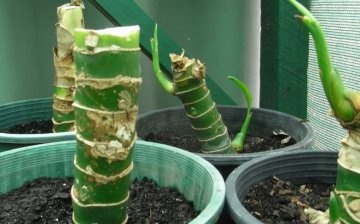
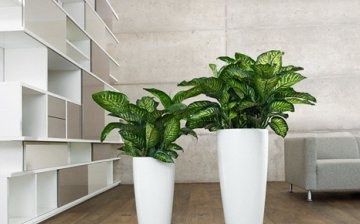
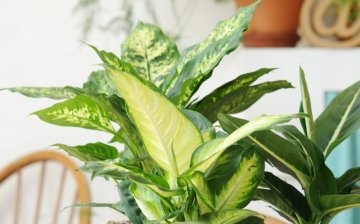

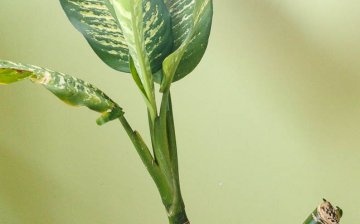
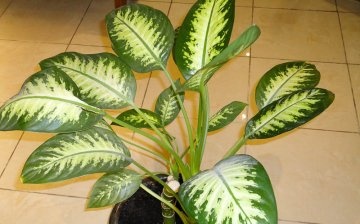






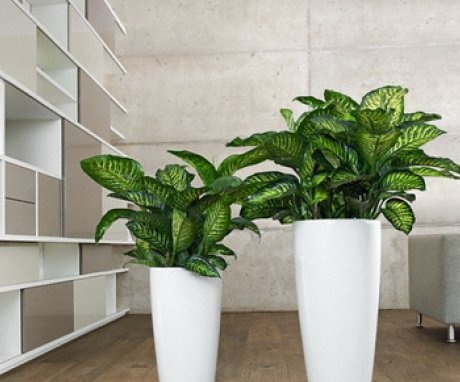
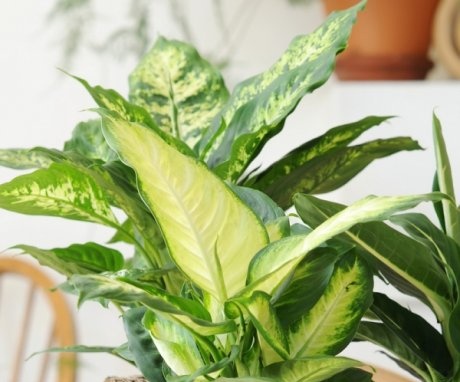
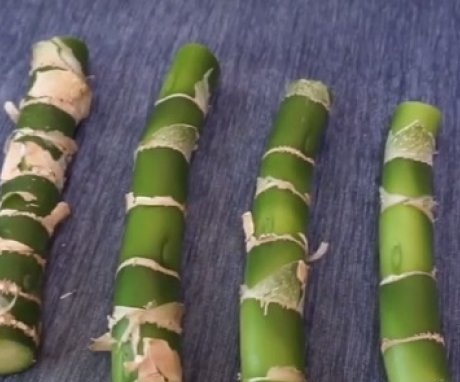
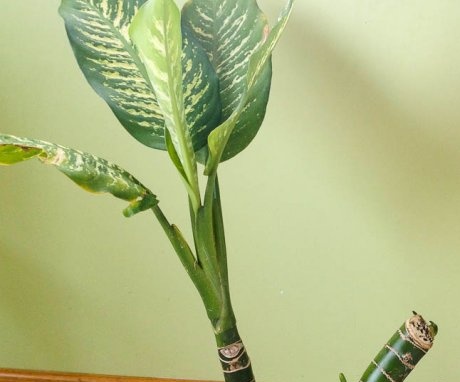
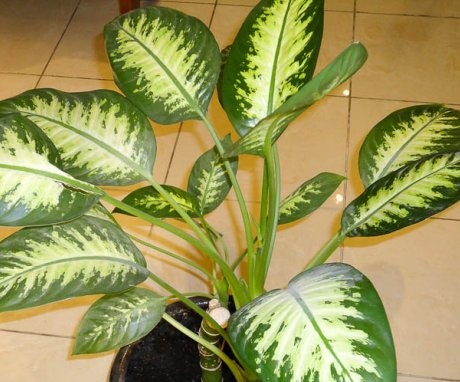
Didn't know that - this plant can purify the air in rooms. Our diphenbachia grows, its height is about 1.5 m, and the leaves are only in several rows at the very top. We have a cat, but he does not touch diphenbachia.
Didn't know that - this plant can purify the air in rooms. Our dieffenbachia grows, its height is about 1.5 m, and the leaves are only in several rows at the very top. We have a cat, but he does not touch Dieffenbachia.
I had this plant before, I did not cut the top, indeed, in a couple of years it grew very tall. If you cut off the top, then a bush will form? That's why I gave my dieffenbachia, it grew almost to the shelf.
I had this plant before, I did not cut the top, indeed, in a couple of years it grew very tall. If you cut off the top, then a bush will form? That's why I gave my dieffenbachia, it grew almost to the ceiling.